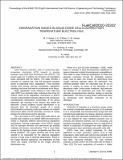| dc.contributor.author | Sohal, M. S. | |
| dc.contributor.author | O’Brien, J. E. | |
| dc.contributor.author | Stoots, C. M. | |
| dc.contributor.author | Virkar, A. | |
| dc.contributor.author | Sharma, Vivek Inder | |
| dc.contributor.author | Yildiz, Bilge | |
| dc.date.accessioned | 2018-07-24T16:15:09Z | |
| dc.date.available | 2018-07-24T16:15:09Z | |
| dc.date.issued | 2010-06 | |
| dc.identifier.isbn | 978-0-7918-4404-5 | |
| dc.identifier.uri | http://hdl.handle.net/1721.1/117078 | |
| dc.description.abstract | Idaho National Laboratory (INL) is performing high-temperature electrolysis (HTE) research to generate hydrogen using solid oxide electrolysis cells (SOECs). The project goals are to address the technical and degradation issues associated with the SOECs. This paper provides a summary of ongoing INL and INL-sponsored activities aimed at addressing SOEC degradation. These activities include stack testing, post-test examination, degradation modeling, and issues that need to be addressed in the future. Major degradation issues relating to solid oxide fuel cells (SOFC) are relatively better understood than those for SOECs. Some of the degradation mechanisms in SOFCs include contact problems between adjacent cell components, microstructural deterioration (coarsening) of the porous electrodes, and blocking of the reaction sites within the electrodes. Contact problems include delamination of an electrode from the electrolyte, growth of a poorly (electronically) conducting oxide layer between the metallic interconnect plates and the electrodes, and lack of contact between the interconnect and the electrode. INL's test results on HTE using solid oxide cells do not provide clear evidence as to whether different events lead to similar or drastically different electrochemical degradation mechanisms. Post-test examination of the SOECs showed that the hydrogen electrode and interconnect get partially oxidized and become nonconductive. This is most likely caused by the hydrogen stream composition and flow rate during cooldown. The oxygen electrode side of the stacks seemed to be responsible for the observed degradation because of large areas of electrode delamination. Based on the oxygen electrode appearance, the degradation of these stacks was largely controlled by the oxygen electrode delamination rate. Virkar et al. [19-22] have developed a SOEC model based on concepts in local thermodynamic equilibrium in systems otherwise in global thermodynamic nonequilibrium. This model is under continued development. It shows that electronic conduction through the electrolyte, however small, must be taken into account for determining local oxygen chemical potential within the electrolyte. The chemical potential within the electrolyte may lie out of bounds in relation to values at the electrodes in the electrolyzer mode. Under certain conditions, high pressures can develop in the electrolyte just under the oxygen electrode (anode)/electrolyte interface, leading to electrode delamination. This theory is being further refined and tested by introducing some electronic conduction in the electrolyte. | en_US |
| dc.description.sponsorship | United States. Department of Energy. Office of Energy Efficiency and Renewable Energy | en_US |
| dc.description.sponsorship | United States. Office of the Assistant Secretary for Nuclear Energy | en_US |
| dc.publisher | ASME International | en_US |
| dc.relation.isversionof | http://dx.doi.org/10.1115/FuelCell2010-33332 | en_US |
| dc.rights | Article is made available in accordance with the publisher's policy and may be subject to US copyright law. Please refer to the publisher's site for terms of use. | en_US |
| dc.source | ASME | en_US |
| dc.title | Degradation Issues in Solid Oxide Cells During High Temperature Electrolysis | en_US |
| dc.type | Article | en_US |
| dc.identifier.citation | Sohal, M. S., J. E. O’Brien, C. M. Stoots, V. I. Sharma, B. Yildiz, and A. Virkar. “Degradation Issues in Solid Oxide Cells During High Temperature Electrolysis.” ASME 2010 8th International Fuel Cell Science, Engineering and Technology Conference: Volume 1 (2010). | en_US |
| dc.contributor.department | Massachusetts Institute of Technology. Department of Materials Science and Engineering | en_US |
| dc.contributor.department | Massachusetts Institute of Technology. Department of Nuclear Science and Engineering | en_US |
| dc.contributor.mitauthor | Sharma, Vivek Inder | |
| dc.contributor.mitauthor | Yildiz, Bilge | |
| dc.relation.journal | ASME 2010 8th International Fuel Cell Science, Engineering and Technology Conference: Volume 1 | en_US |
| dc.eprint.version | Final published version | en_US |
| dc.type.uri | http://purl.org/eprint/type/ConferencePaper | en_US |
| eprint.status | http://purl.org/eprint/status/NonPeerReviewed | en_US |
| dc.date.updated | 2018-07-23T12:31:06Z | |
| dspace.orderedauthors | Sohal, M. S.; O’Brien, J. E.; Stoots, C. M.; Sharma, V. I.; Yildiz, B.; Virkar, A. | en_US |
| dspace.embargo.terms | N | en_US |
| dc.identifier.orcid | https://orcid.org/0000-0002-2688-5666 | |
| mit.license | PUBLISHER_POLICY | en_US |
